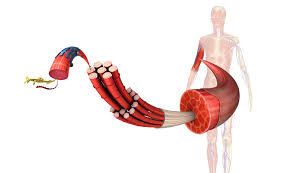Myofascial Release: What It Is and Why Your Body Might Be Asking for It
- Lauren Walker
- Jul 26
- 4 min read
If you've ever felt like your muscles are stiff, sore, or “stuck,” you're not alone. Chronic tension, injury, poor posture, and even stress can cause our muscles and surrounding connective tissues to become tight and restricted. That’s where myofascial release comes in—a gentle yet powerful therapy designed to free up your body’s natural movement and ease deep-seated pain.
But what exactly is myofascial release? And why are so many people turning to it for relief?
Let’s break it down.

What Is Myofascial Release?
“Myofascial” refers to muscle (myo) and fascia, the web-like connective tissue that surrounds and supports your muscles, bones, and organs. Think of fascia as a flexible but strong internal spiderweb—it helps maintain your structure and facilitates movement.
When fascia is healthy, it’s supple and elastic. But injury, trauma, stress, or even poor posture can cause fascia to become tight, dehydrated, or stuck. This creates tension, restricted movement, and chronic pain—often in areas far from the original source.
Myofascial release is a hands-on therapy that uses sustained, gentle pressure to stretch and release these fascial restrictions, restoring mobility and reducing pain.
What Does It Feel Like?
Unlike traditional massage, which often focuses on kneading or rubbing muscles, myofascial release involves:
Gentle pressure
Slow, sustained holds
Stretching and “melting” into the tissue
There are no oils or lotions used, because the therapist needs friction to connect with and stretch the fascia.
Clients often describe the sensation as deep, relaxing tension relief—like the body is finally letting go of something it’s been holding onto for years.

Conditions Myofascial Release May Help
Myofascial release is used to address a wide range of issues, including:
Chronic neck and back pain
Headaches and migraines
TMJ (jaw pain)
Fibromyalgia
Plantar fasciitis
Carpal tunnel syndrome
Sciatica
Postural imbalances
Limited range of motion
Recovery from injury or surgery
Because fascia runs throughout the body, restrictions in one area can cause pain or dysfunction elsewhere. Myofascial release helps untangle those hidden connections.

Benefits of Myofascial Release
Here are just a few reasons people seek out this unique therapy:
✅ Lasting Pain Relief
Releasing fascial restrictions at the root can reduce chronic pain that hasn't responded to other treatments.
✅ Better Mobility and Flexibility
Once fascia is freed, muscles and joints can move more easily and with less resistance.
✅ Improved Posture
By unwinding deep tensions, myofascial release helps realign your body and reduce strain caused by poor posture.
✅ Stress Relief
The slow, mindful nature of the therapy calms the nervous system, promoting deep relaxation and emotional release.
✅ Enhanced Athletic Recovery and Performance
Athletes often use myofascial release to prevent injuries, reduce recovery time, and improve performance.
What to Expect in a Session
A typical myofascial release session involves:
Assessment – Your therapist will observe your posture and movement, and ask about areas of pain or restriction.
Hands-on work – You’ll lie on a massage table while the therapist applies gentle, sustained pressure to specific areas.
Patient awareness – You may be asked to focus on sensations or breathe into certain areas to help release tension.
You might feel soreness or emotional release during or after the session—this is normal as your body adjusts and lets go of long-held restrictions.
Self-Myofascial Release at Home
While working with a trained therapist offers the most targeted results, you can also practice self-myofascial release using:
Foam rollers
Massage balls (like lacrosse or therapy balls)
Stretching techniques
Consistency is key. Gentle, regular sessions can help keep your fascia hydrated, mobile, and healthy.
Final Thoughts
Myofascial release is more than just a technique—it’s a holistic approach to healing the body by honoring how everything is connected. Whether you’re recovering from injury, managing chronic pain, or just feeling stiff and stuck, this gentle yet transformative therapy can help restore balance, ease, and freedom in your body.
If your muscles feel like they’re wrapped in a tight net, it might not be “just” muscle tension—it could be your fascia asking for attention.
Interested in trying myofascial release? Reach out to a certified therapist in your area or book a session with someone trained in this powerful modality. Your body may thank you in ways you didn’t expect.
Relish Well-ness to the Core with our Relaxing Massage Sessions: Wellness Rituals offers effective alternative healing therapies such as Thai Yoga Massage or our Table Top Stretch Sessions. This unique healing therapy incorporates Yoga, pressure points, and reflexology, aiming to reduce body fatigue.
Relish A True Sense of Well-Being Through Expert Services
We use experienced approaches to promote good health in our clients through relaxing spa treatments and life-changing wellness services because We Care for You the Most!
Thank you for following us! Don't forget to find us via our website @www.myrituals.me or check out our latest blog posts on our Facebook and Instagram pages.
Let's stay connected through our social networks including Facebook, Instagram, and LinkedIn all are found at
Facebook : https://www.facebook.com/wellnessrituals
Instagram: https://www.instagram.com/wellnessritualsme
You can always BOOK ONLINE!
Orlando Location: www.vagaro.com/mywellnessrituals
Longwood Location: www.vagaro.com/wellnessrituals-longwood
Text to Book: 407-535-2331. Thank you for following us!
You'll see that we have something new posted every day - so keep checking back!



Comments